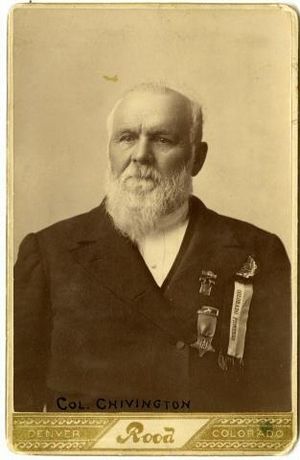John Chivington facts for kids
Quick facts for kids
John M. Chivington
|
|
|---|---|
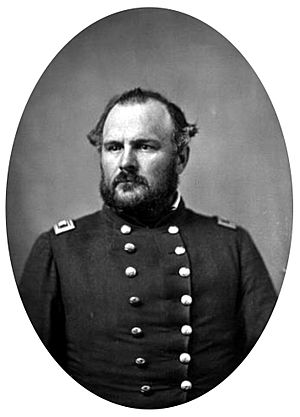 |
|
| Born | January 27, 1821 Lebanon, Ohio |
| Died | October 4, 1894 (aged 73) Denver, Colorado |
| Place of burial |
Fairmount Cemetery, Denver, Colorado
|
| Allegiance | United States of America |
| Service/ |
United States Army Union Army |
| Years of service | 1861–1864 |
| Rank | |
| Commands held | 1st Colorado Infantry Regiment 1st Colorado Cavalry Regiment 3rd Colorado Cavalry Regiment |
| Battles/wars | American Civil War |
| Other work | Methodist preacher |
John Milton Chivington (January 27, 1821 – October 4, 1894) was an American Methodist pastor and Mason who served as a colonel in the United States Volunteers during the New Mexico Campaign of the American Civil War. He led a rear action against a Confederate supply train in the Battle of Glorieta Pass, and was then appointed a colonel of cavalry during the Colorado War.
Colonel Chivington gained infamy for leading the 700-man force of Colorado Territory volunteers responsible for one of the most heinous atrocities in American military history: the November 1864 Sand Creek massacre. An estimated 70 to 163 peaceful Cheyenne and Arapaho – about two-thirds of whom were women, children, and infants – were murdered by Col. Chivington and the volunteer troops under his command.
The Joint Committee on the Conduct of the War conducted an investigation of the massacre, but while they condemned Chivington's and his soldiers' in the strongest possible terms, no court-martial proceedings were brought to bear against him or them. The only punishment Col. Chivington suffered was public exposure and the end of his political aspirations.
Three years prior to Sand Creek, on August 2, 1861, he became the first Grand Master of Masons of Colorado. Several Freemasons, some of whom were present at the Sand Creek Massacre, objected to Chivington's actions and publicly denounced them, while others supported him.
Contents
Early life
Chivington was born in Lebanon, Ohio on January 27, 1821, the son of Isaac and Jane Chivington, who had fought under General William Henry Harrison against members of Tecumseh's Confederacy at the Battle of the Thames.
Drawn to Methodism, Chivington became a minister. Following ordination in 1844, his first appointment was to Payson Circuit in the Illinois Conference. On the journey from Ohio to Illinois, Chivington contracted smallpox. He served the Illinois conference for ten years. In 1853, he worked in a Methodist missionary expedition to the Wyandot people in Kansas, a part of the Kansas–Nebraska Annual Conference. His outspoken views in favor of abolitionism put him in danger, and upon the advice of "Congressman Craig and other friends," Chivington was persuaded to leave the Kansas Territory for the Nebraska Territory.
As a result, the Methodist Church transferred Chivington to a parish in Omaha, Nebraska. Chivington left this position after a year. Historian James Haynes said of Chivington's pastoral abilities: "Mr. Chivington was not as steady in his demeanor as becomes a man called of God to the work of the ministry, giving his ministerial friends regret and even trouble in their efforts to sustain his reputation."
In May 1860, Chivington moved, with his family, to the Colorado Territory and settled in Denver. From there, he sought to establish missions in the South Park mining camps in Park County. He was elected Presiding Elder of the new Rocky Mountain District and served in that capacity until 1862. Controversy began to mar Chivington's appointment, who stopped performing his function as presiding elder. Chivington was not reappointed at the 1862 conference; rather, his name was recorded as "located." According to early Methodist polity, describing a minister as "located" means that the minister has effectively been retired. Historian of Methodism Isaac Beardsley, a personal friend of Chivington, suggested that Chivington was "thrown out" because of his involvement with the armed forces. Chivington's status as being "located" did not remove him completely from Methodist politics. His name appears as a member of the executive board of Colorado Seminary, the historic precursor of the University of Denver and the Iliff School of Theology. His name also appears in the incorporation document issued by the Council and House of Representatives of the Colorado Territory, which was approved by then governor John Evans.
Civil War
When the Civil War broke out, Colorado Territorial Governor William Gilpin offered him a commission as a chaplain, but Chivington refused it, saying he wanted to fight. He was commissioned a major in the 1st Colorado Infantry Regiment under Colonel John P. Slough.
During Confederate General Henry Hopkins Sibley's offensive in the East Arizona and New Mexico territories, Chivington led a 418-man detachment to Apache Canyon. On March 26, 1862, they surprised about 300 Confederate Texans under Major Charles L. Pyron. The startled Texans were routed with 4 killed, 20 wounded and 75 captured, while Chivington's men lost 5 killed and 14 wounded. This small victory raised morale in Slough's army. On March 28, Slough sent Chivington and his men on a circling movement, with orders to hit Sibley in the flank once Slough's main force had engaged his front at Glorieta Pass, New Mexico. Chivington got into position above the Pass, but waited in vain for either Slough or Sibley to arrive. While they waited, scouts reported that Sibley's entire supply train was nearby at Johnson's Ranch.
Chivington's command, among whom there was a detail of Colorado Mounted Rangers, descended the slope and crept up on the supply train. They waited for an hour in concealment, then attacked, driving off or capturing the small Confederate guard detail without any casualties. Chivington ordered the supply wagons burned, and the horses and mules slaughtered. Meanwhile, the Battle of Glorieta Pass was raging at Pigeon's Ranch. Chivington returned to Slough's main force to find it rapidly falling back. The Confederates had won the Battle of Glorieta Pass, but because of Chivington and his forces, they had no supplies to sustain their advance and were forced to retreat. Chivington had completely reversed the result of the battle. Sibley's men reluctantly retreated back to Texas and never again threatened New Mexico.
Chivington earned high praise for his decisive stroke at Johnson's Ranch, even though his discovery of the Confederate supply train was accidental. Critics have suggested that had Chivington returned quickly to reinforce Slough's army when he heard gunfire, his 400 extra men might have allowed the Union to win the battle.
In April 1862, Chivington was appointed colonel of the 1st Colorado Cavalry Regiment. The darker side of Chivington was revealed in the complaints of a captured Confederate chaplain, who wrote that Chivington had threatened to kill the prisoners whom he took at Johnson's Ranch. In November 1862, Chivington was appointed brigadier general of volunteers, but the appointment was withdrawn in February 1863.
Sand Creek Massacre
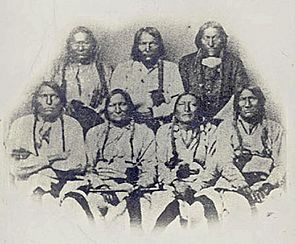
In the fall of 1864, several events took place. Major Edward Wynkoop received a letter from Black Kettle requesting a peace council and an exchange of prisoners, and Wynkoop succeeded in holding a conference with multiple Cheyenne and Arapaho chiefs, including Black Kettle and Left Hand, and securing the release of some prisoners who had been taken during earlier Dog Soldier raids. Wynkoop and Captain Silas Soule, after the peace conference, traveled to Denver with both the returned prisoners and some of the chiefs. Wynkoop convinced a reluctant Territorial Governor John Evans to meet with the chiefs. Known as the Camp Weld Conference, it resulted in Evans making an offer of protection to those Indians who would surrender to Major Wynkoop at Fort Lyon. The chiefs agreed, and, after gathering their peaceful tribes, camped about 40 miles north of Fort Lyon, at Big Sandy Creek.
Around the same time, Gov. Evans received permission from the War Department to found the 3rd Colorado Cavalry Regiment, which would consist of volunteers who would sign on for 100 days. The purported purpose of the regiment was to protect Denver and the Platte road, and it was assigned to the District of Colorado, commanded by Chivington. For political reasons, Evans had stoked the fears of the populace regarding Indian attacks, and he and Chivington had hoped successful military engagements against the Indians would further their careers. But most of the Indian war parties and attacks were occurring hundreds of miles away.
In October 1864, the 100-day enlistment of the 3rd Colorado Cavalry Regiment was nearing an end, and Chivington's Civil War enlistment had expired, meaning he would soon lose his command position. After learning of the agreement reached with the chiefs, Chivington complained to the head of the Department of Kansas, Samuel R. Curtis, that Major Wynkoop was too conciliatory to the Indians. Curtis replaced Wynkoop with Major Scott Anthony, who agreed with Chivington's goal of Indian eradication. But Major Anthony requested that Wynkoop stay and advise him for a short period, despite being under orders from Curtis to end the protection of the Arapaho and Cheyenne encamped near Fort Lyon, and end the distribution of provisions that had also been promised.
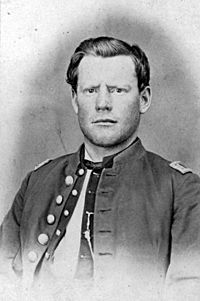
After resettling his mostly Southern Cheyenne people, and hearing from Major Anthony that the distribution of provisions was ended, Black Kettle sent most of his warriors to hunt, leaving only 60 men in the village, most of them too old or too young to hunt. Dog soldiers and other Indian warriors were not part of the Sand Creek encampment.
In November, setting out from Fort Lyon, Colonel Chivington and his eight hundred troops of the 1st and 3rd Colorado cavalry regiments along with a company of 1st New Mexico Volunteer Infantry marched nearly to the reservation. On the morning of November 29, 1864, Chivington ordered his troops to attack.
Captain Silas Soule believed the Indians to be peaceful and refused to follow Chivington's order and told his men to hold fire. Other soldiers in Chivington's force, however, immediately attacked the village. Ignoring the U.S. flag, and a white flag they raised shortly after the soldiers began firing. The attack became known as the Sand Creek Massacre.
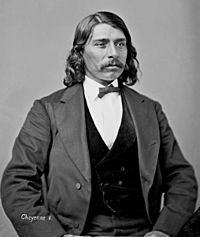
The Colorado forces lost 15 killed and more than 50 wounded, mostly due to friendly fire (likely caused by their heavy drinking). Between 150 and 200 Indians were estimated dead, nearly all women and children. Chivington testified before a Congressional committee that his forces had killed 500 to 600 Indians and that few of them were women or children. Others testified against him.
A prominent mixed-race Cheyenne witness named Edmund Guerrier, said that about 53 men and 110 women and children were killed.
With Chivington's declaring his forces had won a battle against hostile Cheyenne, the action was initially celebrated as a victory. However, the testimony of Soule and his men resulted in a U.S. Congressional investigation into the incident, which concluded that Chivington had acted wrongly.
Soule and some of the men whom he commanded testified against Chivington at his U.S. Army court martial. Chivington denounced Soule as a liar. Within three months, Soule was murdered by a soldier who had been under Chivington's command at Sand Creek. Some believed Chivington may have been involved.
Irving Howbert, an 18-year-old cavalryman who later became one of the founders of Colorado Springs, long defended Chivington's role in the events. In his autobiographical Memories of a Lifetime in the Pike's Peak Region, Howbert argues that the Indian women and children were not attacked, but a few who did not leave the camp were killed once the fighting began. He said that the number of warriors in the village was about equal to the force of the Colorado cavalry. According to Howbert, Chivington was retaliating for Indian attacks on wagon trains and settlements in Colorado and for the torture and the killings of citizens during the preceding three years; evidence of attacks on the white settlers was found in the Indian camp after the battle.
Howbert also said that the account of the battle made to the United States Congress by Lieutenant Colonel Samuel F. Tappan was inaccurate. He accused Tappan of giving a false view of the battle because Tappan and Chivington had been military rivals.
Chivington was soon condemned for his part in the massacre, but he had already resigned from the Army. The general post-Civil War amnesty meant that criminal charges could not be filed against him. An Army judge publicly stated that the Sand Creek massacre was "a cowardly and cold-blooded slaughter". Public outrage at the brutality of the massacre was intense. It was believed to have contributed to public pressure to change Indian policy. The Congress later rejected the idea of a general war against the Indians of the Middle West.
Later life and death
Chivington resigned from the army in February 1865. In 1865 his son, Thomas, drowned and Chivington returned to Nebraska to administer the estate. There he became an unsuccessful freight hauler. He married his daughter-in-law, Sarah. In October 1871, she obtained a decree of divorce for non-support.
Public outrage forced Chivington to withdraw from politics and kept him out of Colorado's campaign for statehood.
In July 1868, Chivington went to Washington, D.C. in an unsuccessful pursuit of a $37,000 claim for Indian depredations. He returned to Omaha, but journeyed to Troy, New York during 1869 to stay with Sarah's relatives. He borrowed money from them but did not repay. Sarah recalled that they returned to Washington in the spring of 1870 and Chivington "spent his time trying to get money without labor."
After living briefly in California, Chivington returned to Ohio to farm. Later he became editor of a local newspaper. In 1883, he campaigned for a seat in the Ohio legislature, but withdrew when his opponents drew attention to the Sand Creek Massacre.
He returned to Denver where he worked as a deputy sheriff until shortly before his death from cancer in 1894. His funeral took place at the city's Trinity United Methodist Church before his remains were interred at Fairmount Cemetery.
To the end of his life, Chivington maintained that Sand Creek had been a successful operation. Until he died, Chivington still claimed to have been justified in ordering the attack, consistently stating, "I stand by Sand Creek."
Legacy
In 1887, the unincorporated settlement of Chivington, Colorado, was established and named after John Chivington. The railroad town on the Missouri Pacific Railroad line was fairly close to the site of the massacre. In the 1920s and 1930s, it was largely depopulated by the Dust Bowl, but some buildings still remain.
Because of Chivington's position as a lay preacher, in 1996 the General conference of the United Methodist Church expressed regret for the Sand Creek massacre. It issued an apology to the Southern Cheyenne for the "actions of a prominent Methodist".
In 2005, the City Council of Longmont, Colorado, agreed to change the name of Chivington Drive in the town following a two-decade campaign. Protesters had objected to Chivington being honored for the Sand Creek Massacre. The street was renamed Sunrise Drive.
In popular culture
- In George Sherman's 1951 Western Tomahawk, set several years after the Sand Creek massacre, Army Lt. Rob Dancy brags to Julie Madden, whose wagon his patrol is escorting, about having ridden with Chivington years before. The movie's main character, frontiersman Jim Bridger, later tells Julie that his wife had been chief Black Kettle's daughter and that the teenage Cheyenne girl accompanying him, Monahseetah, is her sister and the only survivor of a massacre perpetrated by Chivington and his men. Bridger suspects Dancy to be his wife's murderer and pursues him after Dancy escapes from a battle with the Sioux he had provoked against orders. When confronted, Dancy confirms Bridger's suspicion by claiming to have acted on orders. While Bridger is still beating him up, Dancy is shot by a young Sioux whose friend Dancy had killed (thus initiating the conflict) early in the story.
- The American television series Playhouse 90 broadcast "Massacre at Sand Creek" on December 27, 1956. It recounted the massacre and the court-martial of Chivington, but changed the names of those involved. Chivington became John Templeton, played by Everett Sloane.
- Ainslie Pryor had an uncredited role as Chivington in the 1957 film, The Guns of Fort Petticoat, with Audie Murphy as Lt. Frank Hewitt, Hope Emerson as Hannah Lacey, Jeanette Nolan as Cora Melavan, and Sean McClory as Emmett Kettle.
- The episode "Handful of Fire" (December 5, 1961) of NBC's Laramie western series is loosely based on historical events. A Colonel John Barrington, played by George Macready, and presumably modeled on John Chivington, escapes while facing a court martial at Fort Laramie for his role in the Wounded Knee Massacre in South Dakota in 1890. The Laramie episode reveals that series character Slim Sherman (John Smith) had been present at Wounded Knee and hence testified against Barrington. Then Barrington's daughter, Madge, played by Karen Sharpe, takes Slim hostage. She has papers which she contends justify her father's harsh policies against the Indians. Slim escapes but is trapped by the Sioux and must negotiate with the Indians to save the party from massacre.
- Soldier Blue is a 1970 American Western movie directed by Ralph Nelson and inspired by events of the 1864 Sand Creek massacre.
- James A. Michener loosely based his character Frank Skimmerhorn in the novel Centennial on Chivington. In the 1978 miniseries based on Michener's novel, Frank Skimmerhorn was portrayed by Richard Crenna.
- Dee Brown's fictional novel Creek Mary’s Blood (1980) has a character of a drunken trader and political colonel who instigates an Indian village massacre in Colorado; loosely based on Chivington.
- In The Listening Sky, Dorothy Garlock portrayed Chivington as the father of Jane Love. The book provides background detail on Chivington.
- In the TNT mini-series, Into the West, Chivington was portrayed by Tom Berenger.
- Peter La Farge's song "The Crimson Parson" is about the massacre at Sand Creek.
- Fabrizio De Andrè and Massimo Bubola's song "Fiume Sand Creek" is about the massacre at Sand Creek.
- The 2018 novel There There written by Tommy Orange references the massacre at Sand Creek.
- In the 1993 pilot episode of Dr. Quinn, Medicine Woman, Colonel John Chivington is played by Adrian Sparks. Chivington is featured as the antagonist of the episode, with the Sully character (played by Joe Lando) bringing in Chief Black Kettle (played by Nick Ramus), to Dr. Quinn's home saying that quote, "He's been shot. Chivington and his men led a raid on the Sand Creek Reservation and killed everyone. Even the women and children."
See also
 In Spanish: John M. Chivington para niños
In Spanish: John M. Chivington para niños


